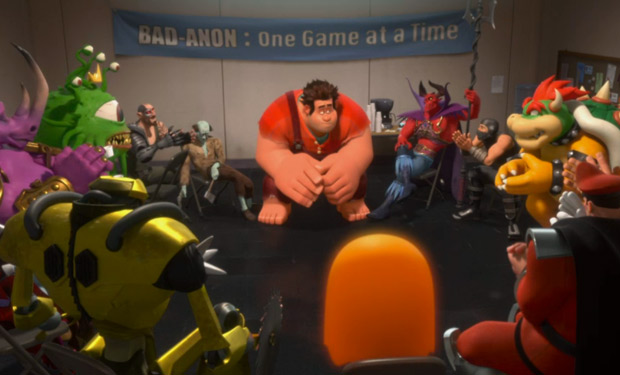Culture
A new hero named “Ralph”

Wreck-It Ralph
dir. Rich Moore
Release Date: Nov 02, 12
- 1
- 2
- 3
- 4
- 5
- 6
- 7
- 8
- 9
- 10
Every day for the past 30-ish years, Wreck-It Ralph (John C. Reilly) has dutifully showed up for work, on time and playing his part. Unfortunately for Ralph, that part involves him being thrown off the roof of a ritzy building by the tenants, after having his attempts to destroy it thwarted by the go-getting Fix-It Felix (Jack McBrayer). As a reward for doing his job, Ralph heads back to his home in the adjacent dump, watching as Felix receives a medal for his heroism. Ralph and Felix are the antagonist and protagonist of an arcade game called Fix-It Felix, an 80s-era cabinet equally modeled on Donkey Kong and Q*Bert. Likewise, Wreck-It Ralph is a film equally modeled on the classic, inspirational message-heavy Disney animation tradition and the pathos and age-transcendent humor of the best Pixar releases.
One day, Ralph decides he wants a hero medal and a celebration for all his hard work, and upsets the balance of the entire arcade by going rogue and entering a Halo-esque game called Hero’s Duty, where the gruff Calhoun (Jane Lynch) sends soldiers into gruesome battle with a horde of wasp-like aliens. Through an escalating series of chaotic circumstances, Ralph indeed gets his medal, only to find himself trapped in Sugar Rush, a game best described as Mario Kart by way of Candy Land. There, he meets Vanellope (Sarah Silverman), a pint-sized glitch within the game, who just wants to enter the race for once despite the wishes of her fellow competitors and King Candy (Alan Tudyk), ruler and dictator of the Sugar Rush machine.
There’s a lot going on in Wreck-It Ralph, but the film keeps things tight, and at no point do the many disparate plotlines come undone. If anything, the film’s big finale hits precisely the right note of comic anarchy, while also wringing a genuinely touching moment out of the many flashy explosions of animation ahead. That animation is one of Ralph’s biggest charms, in fact, for each character moves in exactly the way you’d expect. With the exception of Ralph, most of the citizens of Fix-It Felix’s world move in jerky ways, slowly box-stepping their way around the game world. The juxtaposition of that with the more refined characters from modern games is one of the many subtle jokes that director Rich Moore executes to perfection. Moore, who’s previously worked on Futurama and the golden era of The Simpsons (including a director’s credit on the legendary “Marge Vs. The Monorail” episode), has the perfect combination of impeccable comic timing and a genuine reverence for the bygone era to which the film nods.
The film’s central ideas of heroism and courage against adversity are nothing if not trite and true, particularly in Disney’s wheelhouse, but here they work, bolstered by the nostalgia of a film that takes place in a series of arcade machines in a brick-and-mortar building next to batting cages. There’s a sweetness to that look back, to a time when arcade gaming was a destination, a time the film wisely acknowledges is largely in the past but still has its charms. When Ralph starts “game jumping,” he encounters pretty much every traditional video game character you can think of, short of Mario. (Bowser appears, at least.) The “Game Central Station” sequence alone demands repeat viewings just to catch every nostalgic callback, as does the AA meeting for game villains. However, the film handily avoids the trappings of fan service; for the most part, the retro game references are effectively integrated into the main story.
For all the promotional materials focused on spot-the-inside-joke references that Ralph has sold itself upon, that main story constitutes the brunt of the film’s runtime, and is a true surprise in the Disney mold. As Ralph tries to figure out how to become a hero on his own terms, and Vanellope discovers that her spastic tendencies might actually be a useful attribute, lessons are learned without the treacle of recent fare like The Princess and the Frog, a fun film that suffered slightly when it remembered that a lesson had to be imparted by film’s end. Wreck-It Ralph makes an oddly affirming point (especially in Vanellope’s final scene) about how nobility and honor have to be negotiated for oneself, rather than fitting into other people’s definitions of hero and villain. It’s an oddly progressive notion, and one that offers a lot for its intended youthful audience. But, like the best Disney films, the point is not nearly so onerous in the film as that description makes it sound. First and foremost, Wreck-It Ralph is a fast-paced, visually delightful blast of a film, the kind of family movie that appears rarely and deserves to be savored when it does.